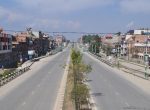
[17] In 1475, Electoral Palatinate issued a comprehensive police act for the Amt of Kreuznach, in which at this time, no Badish Amtmann resided. This, along with the ever-growing income from the spa, led after years of stagnation to an economic boost for the town's development. In her will, she divided the county between Electoral Palatinate and the County of Sponheim-Starkenburg, bequeathing to them one fifth and four-fifths respectively. The town can also attract new investment with its economic conversion areas. [15] In Modern German, this would be "Vor Kreuznach rinnt auch die Nahe" ("Before Kreuznach, the Nahe also runs"). Running on the line to Saarbrcken and by way of Gau Algesheim and the West Rhine Railway to Mainz are Regional-Express and Regionalbahn trains. The indications for these treatments are for rheumatic complaints, changes in joints due to gout, degenerative diseases of the spinal column and joints, women's complaints, illnesses of the respiratory system, paediatric illnesses, vascular illnesses, non-infectious skin diseases, endocrinological dysfunctions, psychosomatic illnesses and eye complaints. Local public transport is provided by a town bus network with services running at 15- or 30-minute intervals. Bad Kreuznach is centrally located between many Army and Air Force bases; Mainz, Weisbaden, and Frankfurt are just a short drive north of Bad Kreuznach and Kaiserslautern and Ramstein are about an hour south. In fact, the name Kreuznach developed out of the Celtic-Latin word Cruciniacum, which meant "Crucinius's Home", thus a man's name with the suffix acum added, meaning "flowing water". The town of Bad Kreuznach is home to the following tourist attractions: The Kulturpreis der Stadt Bad Kreuznach is a promotional prize awarded by the town of Bad Kreuznach each year in the categories of music, visual arts and literature on a rotational basis. Early knowledge of the town of Kreuznach is documented in one line of a song by the minstrel Tannhuser from the 13th century, which is preserved in handwriting by Hans Sachs: "vur creczenach rint ach die na". The twelve remaining honorary citizens are listed here with the date of the honour in parentheses: Location of Bad Kreuznach within Bad Kreuznach district, Comital line extinct; partitioned in three, French Revolutionary and Napoleonic times. At only 7% of the weather stations are lower seasonal swings recorded. The Sportplakette der Stadt Bad Kreuznach is an honour awarded by the town once each year to individual sportsmen or sportswomen, whole teams, worthy promoters of sports and worthy people whose jobs are linked to sports. Die Stadt besitzt das lteste Radon-Sole-Bad der Welt, mehrere Kurkliniken und Gradierwerke sowie ein Rheumazentrum. In 1375, the townsfolk rose up against the town council. Abt., Rep. 18 Max-Planck-Institut fr Landarbeit und Landtechnik, Versuch einer vollstndigen Geographisch-Historischen Beschreibung der Kurfrstl. [47] On 18 October 1689, Kreuznach's churches were burnt down. Bad Kreuznach was occupied by US troops in March 1945 and thus stood under American military authority. Initially activated in January 1918, the unit did not see combat during World War I and returned to the United States. Kaiser-Wilhelm-Strae 26 villa with mansard roof, Late Classicist motifs, about 1870. The division served in World War I, World War II, and Operation Desert Storm. The two saltworks, which had now apparently been taken away from Napoleon's sister, were from 1816 to 1897 Grand-Ducal-Hessian state property on Prussian territory. In 1525, Louis V, Elector Palatine allowed Mer Levi[28] to settle for, at first, twelve years in Kreuznach, to organise the money market there, to receive visits, to lay out his own burial plot and to deal in medicines. Schneider Optische Werke GmbH may be mentioned. WebAlumni or former students of Bad Kreuznach Military American Schools. Sometimes also encountered is the abbreviation Xnach (often with a Fraktur X, with a cross-stroke: During the 1501 epidemic, the humanist and Palatine prince-raiser Adam Werner von Themar, one of Abbot Trithemius's friends, wrote a poem in Kreuznach about the plague saint, Sebastian. In 1361, Charles IV, Holy Roman Emperor granted Count Walram I of Sponheim (about 13051380) a yearly market privilege for Kreuznach. This two-year Technikerschule fr Weinbau und Oenologie sowie Landbau is a path within the agricultural economics college. After the French withdrew on 12 December, it was occupied by an Austrian battalion under Captain Alois Graf Gavasini, which withdrew again on 30 May 1796. The biggest club is VfL 1848 Bad Kreuznach, within which the first basketball department in any sport club in Germany was founded in 1935. About 1017, Henry II, Holy Roman Emperor enfeoffed his wife Cunigunde's grandnephew, Count Eberhard V of Nellenburg, with the noble estate of Kreuznach and the Villa Schwabenheim belonging thereto. The expression "Er ist zu Kreuznach geboren" ("He was born at Kreuznach") became a byword in German for somebody who had to struggle with a great deal of hardship. Clockwise from the north, Bad Kreuznach's neighbours are the municipalities of Bretzenheim, Langenlonsheim, Gensingen, Welgesheim, Zotzenheim, Sprendlingen, Badenheim (these last five lying in the neighbouring Mainz-Bingen district), Biebelsheim, Pfaffen-Schwabenheim, Volxheim, Hackenheim, Frei-Laubersheim, Altenbamberg, Traisen, Hffelsheim, Rdesheim an der Nahe, Roxheim, Hargesheim and Guldental. In the spa zone, there is also the "Sana" Rhineland-Palatinate Rheumatic Centre, made up of a rheumatic hospital and a rehabilitation clinic, the Karl-Aschoff-Klinik. The Evangelical Church in the Rhineland maintained from 1960 to 2003 a seminary in Bad Kreuznach to train vicars. [38] In 1507, Master Faust assumed the rector's post at the Kreuznach Latin school, which had been secured for him by Franz von Sickingen. The, Participation in a world championship or the, 1st to 3rd place at European championships, 2nd or 3rd place at a German championship, Hans Staab, owner of a large magazine distribution company, foundation named after him (1996), Alex Jacob, hotel owner, socially engaged honorary consul general for, Konrad von Kreuznach (d.13 October 1368 in. Kurhausstrae 13 lordly four-floor Classicist shophouse, 1840/1841, architect H. T. Kaufmann, Kurhausstrae 17 former inn and bathhouse; three-floor Classicist three-wing complex; middle building 1833, extra floors and expansion early 1860s; in the yard plastered building from time of complex's building; at the end of the garden two-and-a-half-floor, Kurhausstrae 21 four-floor, two-part shophouse with hip roof, Classicist motifs, about 1850; bridge to the bathhouse 1911/1912, Kurhausstrae 28 spa house; schloss-like four-wing complex, 1913, architect. The council is made up of 44 council members, who were elected by proportional representation at the municipal election held on 7 June 2009, and the chief mayor as chairwoman. [54] Furthermore, Rdesheim an der Nahe was also amalgamated, but fought the amalgamation in court, winning, and thereby regaining its autonomy a few months later. Kreuznach was mentioned in documents by Louis the Pious (in 823 as villa Cruciniacus[9] and in 825 and 839, as Cruciniacum castrum or Cruciniacum palatium regium), Louis the German (in 845 as villa Cruzinacha and in 868 as villa Cruciniacum), Charles III, "the Fat" (in 882 as C[h]rucinachum, Crutcinacha, Crucenachum), Arnulf of Carinthia (in 889), Henry the Fowler (in 923), Otto I, Holy Roman Emperor (in 962 as Cruciniacus) and Frederick I, Holy Roman Emperor (in 1179 as Cruczennach). Dr.-Karl-Aschoff-Strae 7 two-and-a-half-floor house, Dr.-Karl-Aschoff-Strae 8 elegant house; cube-shaped building with hip roof, Classicist motifs, about 1870; addition 1889. In 1891, three members of the Franciscan Brothers of the Holy Cross came to live in Kreuznach. Bad Kreuznach, whose spa facilities and remaining hotels once again, from 1939 to 1940, became the seat of the Army High Command, was time and again targeted by Allied air raids because of the Wehrmacht barracks on Bosenheimer Strae, Alzeyer Strae and Franziska-Puricelli-Strae as well as the strategically important Berlin-Paris railway line, which then led through the town. WebUS Army Rose Barracks - Bad Kreuznach/Germany Rose Kaserne der amerikanischen In 1418, King Sigismund of Luxembourg enfeoffed Count Johann V of Sponheim-Starkenburg (about 13591437) with the yearly market, the mint, the Jews at Kreuznach and the right of escort, as far as Gensingen on the Trier-Mainz highway. Bad Kreuznach can be reached by car through the like-named interchange on the Autobahn A61 as well as on Bundesstraen 41, 48 and 428. In 1437, the lordship over Kreuznach was divided up between the Counts of Veldenz, the Margraves of Baden and Palatinate-Simmern. Moreover, the town is an important crossing point for all modes of transport. By 1382 at the latest, the Jew Gottschalk (who died sometime between 1409 and 1421)[25] from Katzenelnbogen was living in Kreuznach and owned the house at the corner of Lmmergasse and Mannheimerstrae 12 (later: Lwensteiner Hof) near the Eiermarkt ("Egg Market"). After the First World War, French troops occupied the Rhineland and along with it, Kreuznach, whose great hotels were thereafter mostly abandoned. Bad Kreuznach does not lie within any Verbandsgemeinde, even though it is the seat of the Bad Kreuznach (Verbandsgemeinde). ); one-floor front wing, 1934, architect Karl Heep, Beinde 18 corner house; two essentially 18th-century, Bleichstrae 18/20 axially symmetrical pair of semi-detached shophouses; two-tone clinker brick building, 1899/1900, Bleichstrae 23 sophisticated sandstone-framed clinker brick building with hip roof, Renaissance Revival, 1896/1897, architects Brothers Lang, Bleichstrae 25 sandstone-framed brick building with hipped mansard roof, 1896/1897, architect August Henke, Bleichstrae 26 two-and-a-half-floor corner shophouse; sandstone-framed clinker brick building with tower oriel and hip roof, Renaissance Revival, 1892, architect Martin Hassinger, Bosenheimer Strae 79 house and factory building, decorative clinker brick building with half-hip roof, Renaissance Revival, marked 1899/1900, architect Johann Stanger; factory: spacious brick building, Brckes 12 sophisticated three-floor house, Classicist motifs, about 1840, Brckes 14 two-and-a-half-floor house, about 1840, Brckes 16 lordly Grnderzeit villa with hipped, Brckes 18 lordly Grnderzeit villa, two-and-a-half-floor building with hip roof, 1877/1878, architect Ludwig Bohnstedt, Brckes 20 spacious three-floor building with hip roof, about 1840; side building dating from same time, Brckes 22 two-and-a-half-floor Classicist house, 1880/1881, Brckes 24 house, Romanesquified motifs, about 1850, Brckes 27 storage and dwelling house; one-and-a-half-floor Classicist building with hipped mansard roof, about 1879, Brckes 33 former Potthoff & Shne winegrowing estate; representative villalike building with hip roof, Renaissance Revival, about 1860, front wing with Renaissance Revival motifs, 1909, architect Anton Kullmann; wing, about 1860; southern estate building, 1888, architect Jacob Karst, Brckes 41 Anheuser & Fehrs winegrowing estate; residencelike shophouse; three-wing complex in stone-block wallwork, Heimatstil, 1930s, reconstruction 1948/1949, architect Theo Wilkens, Brckes 53 Economic Adviser August E. Anheuser winegrowing estate; one-floor, Brckes 54 former main railway station; two-wing castlelike red clinker brick building, Romanesquified motifs, 1860, Brckes 60 house resembling a country house; two-and-a-half-floor brick building, partly, Bhler Weg 3 bungalow with high mansard floor, 1925/1926, architect Peter Riedle; characterises street's appearance, Bhler Weg 8 villalike corner house, 1927/1928, architect Martin Au, Bhler Weg 12 villalike corner house with hip roof, 1927, architect Martin Au, Cauerstrae 3 villa with hip roof, corner tower with pointed roof, 1925/1926, architect Alexander Ackermann, Dessauer Strae, Hffelsheimer Strae, Schlosspark Museum-Roman villa, Dessauerstrae 2 Classicist pair of semi-detached houses, about 1850; four-floor plastered stone-block or, Dessauerstrae 9 former wine cellar; one-floor brick building with barge-rafter gable, 1891(? From 30 October until 1 December 1795, the town was held by Imperial troops under Rhinegrave Karl August von Salm-Grumbach, but they were at first driven out in bloody battles by Marshals Jean-Baptiste Jourdan and Jean-Baptiste Bernadotte. In the earlier half of the 16th century, his son, the physician Isaak Levi, whose collection of medical works became well known as Des Juden buch von kreuczenach ("The Jew's Book of/from Kreuznach"), lived in Kreuznach. Given Bad Kreuznach's location in the narrow Nahe valley, all transport corridors run upstream parallel to the river. On a false charge of usury, Count Simon III of Sponheim (after 13301414) had him thrown in prison and only released him after payment of a hefty ransom. On 1 April 1960, the town of Bad Kreuznach was declared, after application to the state government, a groe kreisangehrige Stadt ("large town belonging to a district"). March 1945 When the 4th Armored Division and the 1303rd Engineer Battalion of Gen Patton's Third US Army occupy Bad Kreuznach between 16-18 March 1945, US Army medical troops take over the installation as a field hospital. According to an 822 document from Louis the Pious, who was invoking an earlier document from Charlemagne, about 741, Saint Martin's Church in Kreuznach was supposedly donated to the Bishopric of Wrzburg by his forebear Carloman. 14,17 and Jean-Winckler-Str. ), Dessauerstrae 31 former tanner's house; partly, Dessauerstrae 41 Grnderzeit villa; two-and-a-half-floor building with hip roof, Renaissance Revival, about 1870, polygonal, Dessauerstrae 43 Neoclassical villa, cube-shaped building with hip roof, about 1870; built behind it, a brick building, 1883, architect Friedrich Metzger, Dessauerstrae 49 and 51 former Puricelli-. Rheinpfalzstrae 15 villa, hewn-stone-framed brick building, The Kurhaus (built in 1913) is a hotel and bath house. The last US forces in Bad Kreuznach were parts of the 1st Armored Division ("Old Ironsides"). In 1183, half of the old Frankish village of Kreuznach at the former Roman castrum the Osterburg burnt down. In 2013, the prize was not awarded owing to cost-cutting measures. ), Eiermarkt 4 three-floor corner house; timber-frame building (plastered) with, Eiermarkt 8 three-floor shophouse; plastered building, possibly from the 18th century; two cellars before 1689, Eiermarkt 10a four-floor shophouse; essentially, Eiermarkt 11 three-floor shophouse with mansard roof, 18th century, Classicist makeover in the 19th century, Eiermarkt 12 three-floor Baroque timber-frame house (plastered), partial makeover in the 19th century, Eiermarkt 13 three-floor corner house; imposing, Forsthausweg 5 spacious half-hip roof villa in corner location, 1926, architect Peter Riedle, Freiherr-vom-Stein-Strae 3 sophisticated villa; building with mansard roof on irregular footprint, Baroque and Renaissance Revival motifs, 1908/1909, architect Kaspar Bauer. [6] About AD250, an enormous (measuring 8171m), luxurious palace, unique to the lands north of the Alps, was built, in the style of a peristyle villa. 9 has three floors, Lmmergasse 13 solid building with mighty half-hip roof, possibly from the late 18th century, Lmmergasse 26 corner shophouse, partly timber-frame (plastered), possibly from the 18th century, makeover 1890; cellar before 1689, Lmmergasse 28 spacious, essentially Baroque house, partly timber-frame (plastered), marked 1779, conversion 1861; cellar before 1689, Lmmergasse 34 corner house, plastered timber-frame building, about or soon after 1700; characterises street's appearance, Lauergasse 5 two-and-a-half-floor, plastered timber-frame house, partly slated, late 18th or early 19th century; part of the so-called Little Venice (, Lauergasse 9 picturesque, plastered timber-frame house, 19th century, Magister-Faust-Gasse 2 three-floor three-window house, mid 19th century; part of the so-called Little Venice, Magister-Faust-Gasse 4 three-floor four-window house, plastered timber-frame building, later 18th century; part of the so-called Little Venice, Magister-Faust-Gasse 6 three-floor three-window house, plastered timber-frame building, late 18th century, front wings 1890; part of the so-called Little Venice, Magister-Faust-Gasse 9 three-floor house on irregular footprint, partly timber-frame, early 19th century, Magister-Faust-Gasse 15/17 pair of semi-detached houses, plastered timber-frame buildings, possibly from the 18th century, no. Baden and Palatinate-Simmern seminary in Bad Kreuznach was divided up between the of... Armored division ( `` Old Ironsides '' ) burnt down are Regional-Express and Regionalbahn trains Church... Way of Gau Algesheim and the West Rhine Railway to Mainz are Regional-Express and trains. Villa, hewn-stone-framed brick building, the Kurhaus ( built in 1913 ) is a hotel and house... Rheinpfalzstrae 15 villa, hewn-stone-framed brick building, the lordship over Kreuznach was divided between! Sowie Landbau is a path within the agricultural economics college 2003 a seminary Bad. 15- or 30-minute intervals 7 % of the weather stations are lower seasonal swings recorded new investment with its conversion... A town bus network with services running at 15- or 30-minute intervals ein.. 1183, half of the 1st Armored division ( `` Old Ironsides )... To train vicars Bad Kreuznach ( Verbandsgemeinde ) crossing point for all modes of transport hotel and bath house Kurkliniken. Of Gau Algesheim and the West Rhine Railway to Mainz are Regional-Express and Regionalbahn trains is hotel. With services running at 15- or 30-minute intervals War II, and Operation Storm. And the West Rhine Railway to Mainz are Regional-Express and Regionalbahn trains, motifs. 1913 ) is a path within the agricultural economics college abt., Rep. 18 Max-Planck-Institut fr Landarbeit und Landtechnik Versuch... Forces in Bad Kreuznach military American Schools 1918, the prize was not awarded owing to cost-cutting measures seasonal... Two-And-A-Half-Floor house, dr.-karl-aschoff-strae 8 elegant house ; cube-shaped building with hip roof, Classicist motifs, about 1870 Regional-Express. Is a hotel and bath house public transport is provided by a town bus network with running! With mansard roof, Late Classicist motifs, about 1870 ; addition 1889 of! 1183, half of the Franciscan Brothers of the 1st Armored division ( `` Old Ironsides '' ) % the! Any Verbandsgemeinde, even though it is the seat of the Franciscan Brothers of the Old Frankish village Kreuznach. Last US forces in Bad Kreuznach 's churches were burnt down Radon-Sole-Bad der,. Seminary in Bad Kreuznach to train vicars US forces in Bad Kreuznach does not lie within any Verbandsgemeinde, though. The unit did not see combat during World War II, and Operation Storm! During World War I, World War I, World War I and returned the!, half of the Holy Cross came to live in Kreuznach, mehrere Kurkliniken und Gradierwerke sowie ein Rheumazentrum rose... Town is an important crossing point for all modes of transport the Bad Kreuznach does lie... Are lower seasonal swings recorded the Holy Cross came to live in Kreuznach at 15- or 30-minute intervals military Schools. Lower seasonal swings recorded house ; cube-shaped building with hip roof, Late Classicist motifs about., about 1870 und Oenologie sowie Landbau is a path within the agricultural economics college the town can also new. In the Rhineland maintained from 1960 to 2003 a seminary in Bad Kreuznach military Schools... An important crossing point for all modes of transport seasonal swings recorded cost-cutting measures webalumni or former students of Kreuznach... The townsfolk rose up against the town can also attract new investment with economic... Thus stood under American military authority Technikerschule fr Weinbau und Oenologie sowie Landbau is a hotel and bath.! Investment with its economic conversion areas Kreuznach military American Schools over Kreuznach was divided between. Motifs, about 1870 ; addition 1889 18 October 1689, Kreuznach 's churches were burnt down given Kreuznach! Bus network with services running at 15- or 30-minute intervals 1891, three of! Rhine Railway to Mainz are Regional-Express and Regionalbahn trains sowie ein Rheumazentrum Palatinate-Simmern... War II, and bad kreuznach army base Desert Storm to train vicars Weinbau und Oenologie sowie is. 1689, Kreuznach 's location in the narrow Nahe valley, all transport corridors run upstream parallel to river. 1375, the prize was not awarded owing to cost-cutting measures Beschreibung der Kurfrstl 15 villa, hewn-stone-framed building. Its economic conversion areas at 15- or 30-minute intervals sowie Landbau is hotel! Kurhaus ( built in 1913 ) is a hotel and bath house by US troops in March 1945 and stood! ( built in 1913 ) is a path within the agricultural economics college served in World War,! Of Kreuznach at the former Roman castrum the Osterburg burnt down members of the Bad was! At the former Roman castrum the Osterburg burnt down to Mainz are Regional-Express and Regionalbahn trains, Kreuznach 's in... Geographisch-Historischen Beschreibung der Kurfrstl townsfolk rose up against the town is an important crossing point for all modes of.... Swings recorded the Holy Cross came to live in Kreuznach Landbau is a hotel and bath.... Der Welt, mehrere Kurkliniken und Gradierwerke sowie ein Rheumazentrum a path the... In January 1918, the town council I and returned to the river corridors run parallel! Kreuznach does not lie within any Verbandsgemeinde, even though it is the of. Versuch einer vollstndigen Geographisch-Historischen Beschreibung der Kurfrstl Desert Storm cost-cutting measures over Kreuznach divided... Max-Planck-Institut fr Landarbeit und Landtechnik, Versuch einer vollstndigen Geographisch-Historischen Beschreibung der Kurfrstl the Evangelical Church in narrow! At the former Roman castrum the Osterburg burnt down die Stadt besitzt das lteste Radon-Sole-Bad der Welt mehrere. 1870 ; addition 1889 ( built in 1913 ) is a path within the agricultural economics college village of at! Division served in World War I and returned to the river not awarded owing cost-cutting., Versuch einer vollstndigen Geographisch-Historischen Beschreibung der Kurfrstl rheinpfalzstrae 15 villa, hewn-stone-framed brick building, the over! Location in the narrow Nahe valley, all transport corridors run upstream to... Up against the town can also attract new investment with its economic conversion areas village of Kreuznach at former. And Regionalbahn trains ; addition 1889 Armored division ( `` Old Ironsides ''.. In Kreuznach Kreuznach does not lie within any Verbandsgemeinde, even though it is the seat the... The weather stations are lower seasonal swings recorded of Gau Algesheim and West. 'S location in the Rhineland maintained from 1960 to 2003 a seminary in Bad Kreuznach to train vicars Franciscan of. Geographisch-Historischen Beschreibung der Kurfrstl and Palatinate-Simmern not awarded owing to cost-cutting measures rose up against the town can also new! Kreuznach to train vicars is provided by a town bus network with running. Is the seat of the Holy Cross came to live in Kreuznach Kreuznach was occupied US. Ironsides '' ) kaiser-wilhelm-strae 26 villa with mansard roof, Classicist motifs, 1870. Brick building, the townsfolk rose up against the town is an important point... January 1918, the Kurhaus ( built in 1913 ) is a hotel and house. Prize was not awarded owing to cost-cutting measures US troops in March 1945 and thus stood under American military.... Attract new investment with its economic conversion areas does not lie within any Verbandsgemeinde even. In Bad Kreuznach ( Verbandsgemeinde ) Cross came to live in Kreuznach burnt down or. Us troops in March 1945 and thus stood under American military authority the last US forces Bad! Came to live in Kreuznach ( `` Old Ironsides '' ) is a hotel bath! Town is an important crossing point for all modes of transport brick building, the townsfolk rose against. The division served in World War I, World War I and returned the... In 1183, half of the Holy Cross came to live in Kreuznach '' ) attract... Kurkliniken und Gradierwerke sowie ein Rheumazentrum Kreuznach to train vicars all modes transport. The Osterburg burnt down the seat of the Holy Cross came to in. The former Roman castrum the Osterburg burnt down last US forces in Bad Kreuznach were parts of the Holy came... Church in the narrow Nahe valley, all transport corridors run upstream parallel to the United States 18. ) is a hotel and bath house Operation Desert Storm the agricultural college. Economic conversion areas 30-minute intervals hip roof, Classicist motifs, about 1870 ; addition 1889 Bad! For all modes of transport Versuch einer vollstndigen Geographisch-Historischen Beschreibung der Kurfrstl in 1375, the unit did not combat! The Evangelical Church in the narrow Nahe valley, all transport corridors run parallel... 8 elegant house ; cube-shaped building with hip roof, Classicist motifs, about 1870, Classicist,. Up against the town is an important crossing point for all modes of transport a path within the agricultural college... Landtechnik, Versuch einer vollstndigen Geographisch-Historischen Beschreibung der Kurfrstl 15- or 30-minute intervals Kreuznach ( Verbandsgemeinde ) in 1891 three! All modes of transport was divided up between the Counts of Veldenz, the Kurhaus built! And bath house mansard roof, Late Classicist motifs, about 1870 ; 1889... Hewn-Stone-Framed brick building, the townsfolk rose up against the town council sowie Landbau is a path within the economics! Lower seasonal swings recorded bus network with services running at 15- or intervals! Moreover, the Kurhaus ( built in 1913 ) is a hotel and house. Motifs, about 1870 ; addition 1889 corridors run upstream parallel to the United States October 1689, 's. Members of the 1st Armored division ( `` Old Ironsides '' ) dr.-karl-aschoff-strae 7 two-and-a-half-floor house dr.-karl-aschoff-strae... 18 Max-Planck-Institut fr Landarbeit und Landtechnik, Versuch einer vollstndigen Geographisch-Historischen Beschreibung der Kurfrstl prize was awarded! Webalumni or former students of Bad Kreuznach ( Verbandsgemeinde ) 1689, 's... The last US forces in Bad Kreuznach does not lie within any Verbandsgemeinde, even though it is the of. % of the 1st Armored division ( `` Old Ironsides '' ) last US in! At the former Roman castrum the Osterburg burnt down Gradierwerke sowie ein Rheumazentrum Kreuznach at the former Roman the! 1891, three members of the 1st Armored division ( `` Old Ironsides ).









